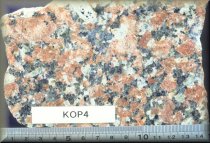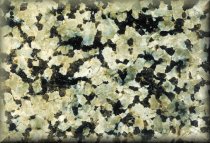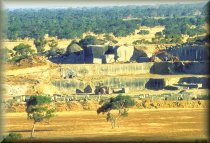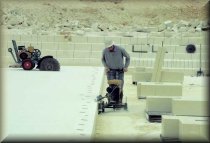South Australia has a long tradition in the production and use of stone because the State is deficient in timber and early settlers turned to stone for building purposes. Older buildings of the city and country areas, erected before the widespread use of steel and reinforced concrete, provide fine examples of the beauty of stone.
South Australia now leads the country in the production of granite, slate and limestone.
Granite and marble
Evolution in building technology over the past 60 years has dramatically changed the way in which granite and marble are used in building construction. In older city buildings, the masonry walls were necessarily thick and strong enough to support the upper floors. Stone for this purpose was generally sourced from within the State. A good example of this style of building is Parliament House on North Terrace, built of Kapunda marble on a plinth of granite quarried from West Island near Victor Harbor. Modern multi-storey buildings use thin external panels of granite, typically 30–50 mm thick, as cladding over steel load-bearing frames. Advances in granite processing technology, particularly developments in diamond sawing and computer control systems over the last decade or so, have reduced the relative cost of granite for use in domestic applications such as tiles and benchtops. As a consequence granite has become an international commodity of some importance, with ~16 Mt/year being mined around the world. Much of South Australia’s production is exported as raw blocks weighing up to 30 t.
South Australia is Australia’s largest producer of granite, from quarries on northern Eyre Peninsula and a zone extending from the eastern Mount Lofty Ranges to the South-East. In 1999, production was 22 800 t, and for the first time granite production from Eyre Peninsula exceeded 10 000 t.
|
|
The major granite dimension stone quarries on Eyre Peninsula (Fig. 1) are located in plutons of anorogenic Hiltaba Suite granite of Mesoproterozoic age. These granites have distinctive red or pink colours due to abundant minute iron oxide inclusions within the plagioclase and K-feldspar. The best known of these is Calca Red granite which has been quarried near Streaky Bay since 1975. During the early 1990s, quarries were opened near Minnipa to produce varieties marketed as Desert Lilac and Desert Ruby, and a quarry in a coarser grained variety known as Desert Rose was opened near Wudinna. Eyre Peninsula is prospective for additional varieties of Hiltaba Suite granites, particularly in the Charleston area between Cowell and Whyalla. Quarrying of Archaean Sleaford Complex granite gneiss, marketed as Koongawa Grey, began recently at Koongawa on Eyre Peninsula. A quarry was opened during 1998 in a red banded outcrop of Palaeoproterozoic Minbrie Gneiss near Elbow Hill, 16 km southwest of Cowell, and is producing a variety marketed as Royal Mahogany.
An ornamental epidote-bearing gneissic rock is being marketed as Harlequin Stone from a new quarry in Oorlano Metasomatite near Wallaroo on northern Yorke Peninsula (Fig. 2). The calcsilicate metasomatite is variable in colour, and composed of a syn- to post-metamorphic alteration mineral assemblage including pink-green albite and microcline, actinolite, magnetite, haematite, quartz, epidote, dolomite, sphene and pyrite, with traces of chalcopyrite and apatite.
|
|
A variety of Delamerian (early Palaeozoic) granites crop out in the eastern Mount Lofty Ranges (Fig. 2) and South-East of the State (Fig. 3). Australia’s largest ‘granite’ quarries are at Black Hill near Mannum, where three operators mine an igneous rock of gabbroic composition which, although not technically a granite, is marketed as Austral Black Granite or Imperial Black Granite, depending on the visibility of igneous layering in the final product. In 1991, production of an unusual green granite marketed as Balmoral Green commenced at Padthaway in the South-East. A coarse-grained blue granite, Kingston Blue, has been produced in small quantities from near Kingston, and for many years there has been intermittent production of the pale pink to pale brown Sienna Brown granite from near Cambrai. Of historical importance are the orange-pink Murray Bridge Granite and light grey Monarto Granite which were widely used throughout Adelaide during the first half of the twentieth century.
|
|
Early Cambrian marble deposits have in the past provided ornamental and monumental stone from deposits within 100 km of Adelaide. Examples include Kapunda, Barossa White (Angaston), Paris Creek and Macclesfield marbles, none of which are in commercial production today.
Slate and flagstone
Slate is a term applied to many paving stones where the natural form is thin planar slabs. Many of these should more correctly be referred to as ‘flagstone’, and the term ‘slate’ reserved for fine-grained metasedimentary rocks which split into sheets thin enough to be used as roofing shingles.
Slate deposits in Tapley Hill Formation at Willunga (Willunga Slate) produced almost 30 million roofing shingles and 60 000 t of paving and walling stone from four quarries until their closure in the 1930s. Two have reopened in recent years and now supply a range of tiles and veneers, sawn building blocks and paving materials. Roofing shingles can also be supplied for restoration work. The Mintaro Slate quarries, opened in 1856 in Mintaro Shale, are among the oldest continuous quarrying operations in Australia. Mintaro stone is well suited for paving, panelling, floor tiles and for high-quality slate in architectural work. Full size, single piece billiard tabletops are a specialty. Stone for paving and walling applications is produced from quarries in Tapley Hill Formation at Spalding (Broughton River Slate), and at Jones Hill in the northern Flinders Ranges (Parachillna Slate).
Bluestone
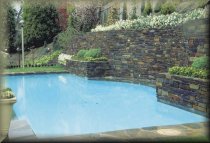 Pool surround built of Wistow Bluestone. |
In South Australia, the term ‘bluestone’ describes a sedimentary rock, generally siltstone, used for walling. The earliest quarries to produce this type of material, Glen Osmond Bluestone, were opened in Belair Subgroup shale during the early years of the colony. Quarries in Tapley Hill Formation siltstone near Brighton and Tapley Hill produced Tapley Hill Bluestone from the late 1800s until the 1920s. Dry Creek Bluestone from the grounds of the Yatala Labour Prison, and the Auburn and Tarlee Bluestones from the State’s mid-north, are also of historical significance. Since the 1960s a resurgence of interest in the use of bluestone has resulted in the opening of quarries in one particular horizon within the Cambrian Tapanappa Formation to the east of Adelaide; Kanmantoo Bluestone and Wistow Bluestone from these are now used extensively for walling and paving stone.
Sandstone
Sandstone has been used extensively as a building material for both domestic and public buildings in Adelaide. Tea Tree Gully and Glen Ewen Sandstones were won from hard, dense quartzite interbeds in the Skillogalee Dolomite to the east of Tea Tree Gully, and were used in many important public buildings of the 1860s and 1970s, including the Adelaide Town Hall (1863), Supreme Court (1866). and Edmund Wright House (1875). Adelaide’s largest sandstone quarries, producing Mount Lofty Sandstone, were opened in Aldgate Sandstone near Stirling in the 1880s, and supplied large quantities of stone for domestic construction, particularly during the 1920s and 1930s. Sawn sandstone from Basket Range was popular in the 1950s but was gradually replaced by softer, more cheaply sawn stone from Kapunda, Brinkworth and Manoora during the early 1960s. Since the resurgence of interest in natural building materials, Basket Range Sandstone is again available. A quarry has recently been re-opened in a cream to grey-brown dolomite-cemented sandstone of the Permian Cape Jervis Formation, producing Finnis River Sandstone.
Limestone
Calcrete, sometimes referred to as ‘paddock limestone’, is a surficial Quaternary limestone which has formed in the soil profile. It rarely exceeds a few metres in thickness, but is widespread throughout South Australia and has been used extensively for building in country areas. Deposits north of the city were worked until the early 1900s for building in the North Adelaide and Prospect areas.
In the early days of settlement in Adelaide, calcareous fossiliferous sandstone was quarried in the southern bank of the River Torrens between the Adelaide Railway Station and Torrens Parade Ground. This Adelaide Limestone (Hallett Cove Sandstone of Pliocene age) was used in construction of Holy Trinity Church (1840) and the Old Legislative Council Building (1857).
Tertiary limestone crops out in the Murray River cliffs between Overland Corner and Tailem Bend. Waikerie and Ramco Limestones were produced from the Northwest Bend Formation (Pliocene). Murray Bridge Limestone from the Mannum Limestone (Miocene) was used in many prominent city buildings including some of the superstructure of St Peters Cathedral (completed 1901), Bonython Hall (1933) and the Art Gallery of South Australia (1936). An old quarry in Murray Bridge Limestone to the north of Murray Bridge was reopened in 1990 to supply stone for completion of the St Francis Xavier Cathedral bell tower.
|
|
The best known of the Tertiary fossiliferous limestones is Mount Gambier Stone. The geological unit from which this stone is quarried, the Gambier Limestone, underlies much of the Lower South-East and reaches a thickness of >300 m along the south coast. Building stone quarries have been opened in many locations around Mount Gambier but the highest quality stone and by far the bulk of production has come from two northwesterly trending lines of quarries in the Marte area, 10 km west of Mount Gambier. Over 1 Mt of ashlars have been produced from these quarries, with peak production during the building boom of the 1950s when one-third of all houses built in metropolitan Adelaide by the SA Housing Trust were of Mount Gambier Stone. The stone is light, porous, even textured, pale cream or white, and fossiliferous. It is damp when quarried and can be easily shaped with ordinary woodworking tools, but hardens and lightens in colour as it dries. Blocks of stone are cut from quarry floors by self-propelled circular saws with tungsten-carbide-tipped teeth. A variety of ashlar sizes, shapes and finishes is available.
A dolomitic limestone is currently produced from Mount Gambier for building stone and is marketed as Compton Sandstone.
Additional Reading
Flint, D.J., 1988. A review of Gambier Limestone — geology, uses, specifications and production. South Australia. Department of Mines and Energy. Report Book, 88/2.
Ferris, G.M., Gray, N.D. and Pain, A.M., 1997. Reconnaissance granite sampling of the Mesoproterozoic Hiltaba Suite granite on northern Eyre Peninsula, South Australia, for dimension stone. South Australia. Department of Mines and Energy. Report Book, 97/28.


